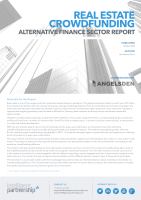
 www.intelligent-partnership.com
www.intelligent-partnership.com
Real Estate Crowdfunding
, ,Alternative Finance Sector Report - October 2014
6
REAL ESTATE CROWDFUNDING
ALTERNATIVE FINANCE SECTOR REPORT
PUBLISHED
October 14
AUTHOR
Samantha Goins
management team in place to handle the
day-to-day operations and this can come
at a high cost. The right management
company can be central to the success of
a property. Commercial properties are
large investments and are often valued
according to their rental yield. Therefore
it is important to have secure long-term
tenants in place, particularly when looking
to sell. Long-term rental contracts often
include break clauses and upward only
rent rises linked to inflation, which can
help to provide inflation proof returns. In
comparison to other European countries,
the UK has some of the most attractive
lease terms available, typically ranging
from 5 to 15 years
9
.
Residential Property
Residential property primarily covers
buy-to-let style investments and now
more commonly city centre apartment
blocks and holiday lettings. Long-term
buy-to-let investments can provide stable
returns as rents historically keep pace
with wage increases and inflation rates,
as long as the property remains tenanted.
In 2013, UK real estate was worth over
£5,096 billion, with residential property
comprising over 85% of that total.
10
Residential property is uncorrelated
to mainstream investments as rents
tend to hold up during periods of
economic distress, so again this can
provide diversification within a balanced
investment portfolio.
Residential property is less exposed
to the business cycle than commercial
property but has higher management
requirements including regular
rent collection, health and safety
requirements, general maintenance and
often a higher turnover of tenants. An
experienced management company can
take care of these duties for a percentage
of rental income, which will impact profits.
If the project fails completely investors
could lose all of their investment,
depending on what assets or property the
developer owns as recourse.
Another consideration is the supply of
properties in the local market. It may take
several years to complete a property and
the market could change dramatically
over this timeframe.
Liquidity is very important, as it is very
hard to find buyers for a property which
isn’t complete or which has run into
trouble. Investors have little control
over the building works or completion
date - they are often soley reliant on the
developer. Funds are released to the
developer once specific build stages
have been met, but if the project is over
budget, they may require more capital to
move to the next stage.
Redeveloping Built Property
A property that is already built and only
in need of refurbishing or re-purposing
is usually a much lower risk proposition.
Some investment properties will already
have sitting occupants producing a
steady income. Returns will often be
easier to forecast and more predictable,
but are likely to be lower than off plan
properties. However the initial capital
outlay is much higher, especially for
established properties with a predictable
revenue stream, reducing the opportunity
for stellar returns.
Properties that have already been built
are likely to be the least risky as regards
to building stage, although this can vary
dramatically depending on the extent
of the work required. Redevelopment
projects could require a large capital
input, planning permission and specialist
skills, particularly if structural work is
required. This will be inherently more
risky than a property that already has
sitting tenants or that only needs basic
general maintenance. Of course the
scale of redevelopment will impact the
potential increase in value. Liquidity
must still be considered, alongside
the timeframe for any maintenance or
development, the performance of the
local market and transaction costs.
Redevelopment properties are often
shorter term investments which look
to add a large amount of value to the
property in order to sell it on at a profit.
Examples include splitting a large
property into flats or modernising a
property in order to add value.
Typical Lease Lengths by Country
Spain
Sweden
France
Germany
Italy
UK
Source: DTZ Annual report 2013
0
5
10
15 20
Overseas residential property
investments can be higher risk as
investors will typically have less
understanding of the local market, so
proper due diligence here is crucial.
Companies such as Savills and Knight
Frank operate on a global scale and can
provide research, market updates and
assistance for key locations all over.
Off-Plan Investments
Off–plan refers to buying a property
before it is built. Properties are often sold
at a pre-development stage as this helps
developers to secure the funding needed
to start the project. Prices are usually
greatly reduced but for obvious reasons
the risks are much higher – investors are
exposed to all of the potential delays
and risks that go with a new build - and
it is often seen as highly speculative.
However there is the possibility of much
higher returns. Once the property is built
investors can sell or lease it out for a
higher profit. In certain locations returns
can reach 25-30% per year.
11
Off-plan is the riskiest way to invest in real
estate and can include a large amount of
speculation. Several problems can arise
before the building is completed. Delays
can occur from the outset: building
permission may not have been granted or
environmental issues could halt the build
and push up costs and result in delays.
The developer could run out of funds and
be unable to finish the property, or they
could run over time which again will result
in further costs. This could make it very
hard for the investor to exit and mean they
have to hold on to their investment for
much longer than originally anticipated.
9 -
http://www.henderson.com/sites/henderson/uk_property/getdoc.ashx?ID=2015010 -
http://www.bpf.org.uk/en/files/reita_files/property_data/BPF_Property_Data_booklet_2013_spreads_web.pdf11 -
http://www.propertyshowrooms.com/guide/buying-off-plan-guide.asp)
Core Commercial Property
Other Commercial Property
Other Non-Domestic Buildings
Residential
£504bn
£65bn
£80bn
£4,447bn
Source: BPF Property Report 2013
UK Property Values (2013)
















